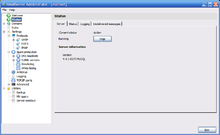
Email is a method of transmitting and receiving messages using electronic devices. It was conceived in the late–20th century as the digital version of, or counterpart to, mail. Email is a ubiquitous and very widely used communication medium; in current use, an email address is often treated as a basic and necessary part of many processes in business, commerce, government, education, entertainment, and other spheres of daily life in most countries.
Within the Internet email system, a message transfer agent (MTA), mail transfer agent, or mail relay is software that transfers electronic mail messages from one computer to another using the Simple Mail Transfer Protocol. In some contexts, the alternative names mail server, mail exchanger, or MX host are used to describe an MTA.
The Simple Mail Transfer Protocol (SMTP) is an Internet standard communication protocol for electronic mail transmission. Mail servers and other message transfer agents use SMTP to send and receive mail messages. User-level email clients typically use SMTP only for sending messages to a mail server for relaying, and typically submit outgoing email to the mail server on port 587 or 465 per RFC 8314. For retrieving messages, IMAP is standard, but proprietary servers also often implement proprietary protocols, e.g., Exchange ActiveSync.

An email client, email reader or, more formally, message user agent (MUA) or mail user agent is a computer program used to access and manage a user's email.

Webmail is an email service that can be accessed using a standard web browser. It contrasts with email service accessible through a specialised email client software. Additionally, many internet service providers (ISP) provide webmail as part of their internet service package. Similarly, some web hosting providers also provide webmail as a part of their hosting package.
An email address identifies an email box to which messages are delivered. While early messaging systems used a variety of formats for addressing, today, email addresses follow a set of specific rules originally standardized by the Internet Engineering Task Force (IETF) in the 1980s, and updated by RFC 5322 and 6854. The term email address in this article refers to just the addr-spec in Section 3.4 of RFC 5322. The RFC defines address more broadly as either a mailbox or group. A mailbox value can be either a name-addr, which contains a display-name and addr-spec, or the more common addr-spec alone.
Various anti-spam techniques are used to prevent email spam.
Sender Policy Framework (SPF) is an email authentication method which ensures the sending mail server is authorized to originate mail from the email sender's domain. This authentication only applies to the email sender listed in the "envelope from" field during the initial SMTP connection. If the email is bounced, a message is sent to this address, and for downstream transmission it typically appears in the "Return-Path" header. To authenticate the email address which is actually visible to recipients on the "From:" line, other technologies such as DMARC must be used. Forgery of this address is known as email spoofing, and is often used in phishing and email spam.
Greylisting is a method of defending e-mail users against spam. A mail transfer agent (MTA) using greylisting will "temporarily reject" any email from a sender it does not recognize. If the mail is legitimate, the originating server will try again after a delay, and if sufficient time has elapsed, the email will be accepted.
The following tables compare general and technical features of notable email client programs.

Mercury Mail Transport System is a standards-compliant mail server developed by David Harris, who also develops the Pegasus Mail client.

Zimbra Collaboration, formerly known as the Zimbra Collaboration Suite (ZCS) before 2019, is a collaborative software suite that includes an email server and a web client.
The comparison of mail servers covers mail transfer agents (MTAs), mail delivery agents, and other computer software that provide e-mail services.
The following tables compare general and technical information for a number of notable webmail providers who offer a web interface in English.
The Courier Mail Server is a mail transfer agent (MTA) server that provides SMTP, IMAP, POP3, SMAP, webmail, and mailing list services with individual components. It is best known for its IMAP server component.

Zarafa was an open-source groupware application that originated in the city of Delft in the Netherlands. The company that developed Zarafa, previously known as Connectux, is also called Zarafa. The Zarafa groupware provided email storage on the server side and offered its own Ajax-based mail client called WebAccess and a HTML5-based, WebApp. Advanced features were available in commercially supported versions. Zarafa has been superseded by Kopano.
Ipswitch IMail Server is an email server application with groupware functionality that runs on Microsoft Windows OS. It was developed in 1994 by Ipswitch, Inc., a software company based in Lexington, Massachusetts.
EmailTray is a lightweight email client for the Microsoft Windows operating system. EmailTray was developed by Internet Promotion Agency S.A., a software development d.
A mailbox provider, mail service provider or, somewhat improperly, email service provider is a provider of email hosting. It implements email servers to send, receive, accept, and store email for other organizations or end users, on their behalf.
MailEnable is a Windows-based, commercial email server distributed by MailEnable Pty. Ltd, an Australian-based software company which was established in 2002.





